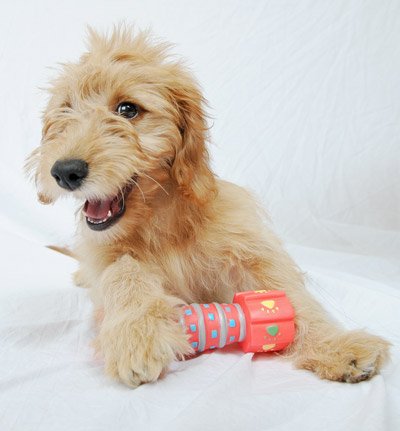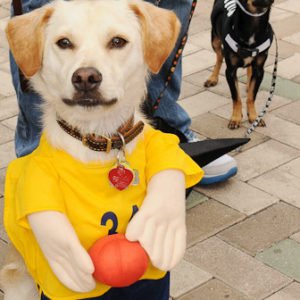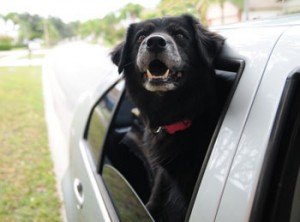Socializing Your Puppy While Social Distancing

With coronavirus requiring social distancing between humans, new puppy owners are finding it harder to make sure their puppy learns about the great big world. But it is possible to provide your puppy with much-needed experiences even while you’re social distancing — and have fun while doing it!
During this coronavirus pandemic, you can take advantage of extra time at home and help your puppy grow into a well-adjusted and well-trained adult. Social distancing with your dog might actually mean better behaved dogs when life gets back to normal.
According to the CDC, there is no current evidence that our pets can spread the coronavirus to humans. However, it’s important to not put yourself or others at risk while working on puppy socialization. Practice appropriate social distancing, wash your hands after interacting with pets, and sanitize often. Check out the University of Illinois School of Veterinary Medicine’s informative FAQ on pets and COVID-19 here for more information.
Don’t Wait Until It’s Too Late to Socialize Your Puppy
Introducing your puppy to the world in a positive way while they’re young is crucial for a happy, well-rounded dog in the future. Lack of socialization during the critical “imprint period” can lead to a higher chance of behavioral issues when the puppy becomes an adult, such as separation anxiety, noise phobia, or leash reactivity and fear aggression.
For all socialization and proactive exposure training, take everything slow and follow your puppy’s lead. Keep socialization practice short and sweet, and start new exposure low and slow.
Tips for Puppy Socialization During COVID-19
Socialization Isn’t Just About Other Dogs and People
While you won’t be able to attend group puppy classes like usual, there are other things to focus on besides dog-dog interactions. Socialization includes common experiences that your dog will have throughout their life, such as handling at the vet or groomer, getting their nails trimmed, the sound of thunderstorms or the vacuum, and different kinds of surfaces they’ll need to walk on (like the bathtub). Luckily, you can practice most of these things from the comfort of your own home. Working on these things at home means less distractions, which will help your puppy learn better and faster!
Non-Social” Puppy Socialization Ideas
Tactile experiences for your puppy
Introducing your puppy to different surfaces can be easy to do at home, on a walk, or in a yard. Here are some ideas:
- A flat baking sheet they can sniff at or walk over
- An empty plastic water bottle to chew on and toss around
- The bathtub (without the actual bath)
- Outside surfaces such as gravel, bark, dirt, garden stepping stones, grass or turf
- A kiddie pool filled with balls
- Different flooring such as wood, linoleum, and carpet
Introduce different scents to your puppy
Dogs brains dedicate a lot of space and energy to their sense of smell, so working your puppy’s nose provides great enrichment and helps burn off energy. Studies have also shown that certain scents help calm dogs and reduce stress behaviors. Make sure any scents you use aren’t irritating or toxic to dogs.
- Dilute essential oil in water (such as lavender) and spray a small amount on a blanket or bedding
- Scatter kibble throughout the yard to encourage sniffing
- Use a snuffle mat for feeding meals
- Play nose work games to teach your puppy to find the “right” smell
- Introduce the smell of other types of animals (gently wipe other animals in your home, such as cats, hamsters, birds, horses etc. with a cloth and let your puppy smell it)
- Set up a scavenger hunt throughout your home by hiding treats and helping your dog sniff them out
 Play Dress Up!
Play Dress Up!
Since your puppy can’t meet lots of different people right now, that doesn’t mean you can’t expose them to different types of clothing or various ways people move. You or a family member can dress up and practice your acting skills. Here are a few ideas to get you started:
- Wearing a hat or sunglasses (or both at the same time!)
- Walking with a cane or walker
- Wigs of different hair colors and styles
- Delivery person carrying a box or package
- Bundled up in rain or winter gear (rubber boots, umbrella, jacket with hood up)
- Riding a bicycle, scooter, or skateboard and wearing a helmet
- Carrying lots of grocery bags
- Wheeling around a suitcase
- Wearing last year’s halloween costume
As always, make sure your pet is comfortable.
Socialize From a Distance
Getting outside is important, not just for your mental health, but also for your puppy to experience the great outdoors. For puppies younger than 16 weeks that shouldn’t be exploring far and wide quite yet, I recommend just sitting in your driveway or on your porch with them to watch the world go by. Have your puppy on a leash for safety and set out a nice mat for them to settle on if they choose.
Any time they notice something new, like a loud truck driving by, a cat walking across the street, or your neighbor heading out for a walk, praise calmly and give them a treat. It’s all about creating positive associations with different things.
It’s also a fantastic opportunity to practice their name recognition and come-when-called cue!
If your puppy is old enough and up-to-date on their required vaccinations, you can start exploring on leashed walks. Most regular dog leashes are at least six feet long, so that also gives you an easy way to make sure you’re staying the recommended distance from other people.
While on walks, create positive associations with people and other dogs as they walk by at a distance. If your puppy notices them, give them a treat. This doesn’t require any actual interaction, just their distant presence. You’ll get a big future training bonus by doing this — your puppy will be better able to focus on you around distractions like other dogs or people!
It’s tempting to let other people greet your adorable puppy while out and about, but I recommend avoiding it right now. Even if you are technically staying six feet apart from other people with your puppy at the end of their leash, there is the risk that coronavirus can be transmitted through touching a contaminated surface, like a dog’s collar, harness, or even fur. For safety’s sake, just wave hello and keep enjoying your socially distanced walk with your puppy.
Outdoor Socialization for Young Puppies
Puppies that haven’t completed their puppy shot series are at higher risk for contracting illnesses such as parvo. If your puppy is still too young or unvaccinated, you can still provide much needed exposure to things outside your home.

Go for a Drive
Taking your puppy for a field trip in the car is a great chance to introduce them to car rides and work on preventing travel anxiety. Take a short drive and park in a large parking lot outside of a grocery store or other business that’s open right now. Sit and watch the world go by with your puppy, rewarding with praise, toy play, or treats when they notice things happening outside.
If possible, park on the outskirts of the parking lot so there’s distance between your puppy and the activity. Then you can sit in the back of your car with the door open to let in more outside noise and scents. Make sure your puppy is on leash and secured so they can’t hop out of the car. If the parking lot is small or too busy, keep your doors and windows closed to ensure social distancing.
Prepare Your Puppy for “Sudden Environmental Change”
A big part of life is the ability to cope with sudden changes in the environment. To prevent anxiety and future reactive behavior, it’s important to help your puppy learn how to bounce back from startling and possibly scary experiences. It’s normal for a dog to be startled by a loud noise or the sudden appearance of a person or dog — we humans often jump at an unexpected noise or if someone we didn’t notice taps us on the shoulder. It’s our ability to calm down quickly afterwards, and not generalize this fight-or-flight reaction to the rest of our day, that helps us stay healthy and happy.
You can foster your puppy’s coping skills with sudden environmental change in a couple of ways:
- Reward your puppy when things suddenly appear. If you’re out on a walk (or sitting in your yard watching the world go by) and a person or dog makes a sudden appearance, give your puppy praise, a treat, or entice them to play with a toy. This is building a positive association with a sudden environmental change and redirecting their attention back to you.
- Comfort, don’t coddle. There is nothing wrong with comforting your puppy if they get scared by something. Keep your own emotions calm, cool, and collected when you do so. Dogs are very attuned to their people’s emotional state (they can smell the hormones and chemicals our body releases), and if they see that you’re not worried about something, they’ll most likely follow your lead. Say “it’s okay!” in a happy voice and pet gently. Then add some distance between you and the person or thing that scared them. If they reacted to a sound, practice noise desensitization in future training sessions using free audio recordings on youtube or an app like the Sound Proof Puppy Training app.
- Give them the opportunity to back away. If something startles your dog, don’t force them to interact with it up close. I once was walking a client’s puppy and a balloon that was tied to a sign started blowing around in the wind. He was rather freaked out by this big red moving balloon and scampered behind me. We backed up to a distance where he was able to watch it without feeling threatened, and I rewarded him with praise and treat whenever he looked at or took a step towards it. After a few minutes of this positive reinforcement for curiosity, he was able to walk right up to the sign and balloon. Find a comfortable distance for your puppy to observe the thing that startled them, and reward them for showing any courage or curiosity.
Playtime
Let your furry family members spend the day with us playing and being pampered. You can relax knowing they have been well cared for all day. We offer boarding and daycare services at these locations only: North Bay Animal Hospital, Pebble Creek Animal Hospital , and Temple Terrace Animal Hospital.
Schedule Virtual Dog Training Sessions
With more and more states initiating stay-at-home orders and requiring non-essential businesses to close, don’t be surprised if puppy-only classes aren’t an option in your area. If you find yourself with no class options like this, it is worth it to schedule a virtual training session with a local certified dog trainer.
A trainer can walk you through basic puppy training and give you ideas on ways to practice at-home handling and socialization tailored to your puppy and lifestyle. They’ll also be able to discuss common puppy behaviors like nipping or chewing, and help you prevent issues like resource guarding. Plus, you’ll be supporting a small business during a tough time!
Provide Lots of Puppy Brain Games
Mental enrichment for your puppy is even more important now that we’re spending more time at home. Not only do brain games like interactive toys and puzzles burn off some of that crazy puppy energy, they also build confidence! Confidence is essential for future resiliency of your dog’s behavior when they encounter new things.
Encourage your puppy to explore new puzzles and solve different problems. Start with easy puzzles and interactive toys so your puppy is successful and doesn’t give up. Slowly increase the difficulty of their puzzle as they get the hang of problem solving. Frustration is part of the game — you want your puppy to learn some frustration tolerance, but not get so frustrated that they give up! Give them a helping hand if they need it and always praise them for their efforts.
While social distancing during this coronavirus pandemic is less than ideal, it doesn’t mean that your puppy won’t grow up to be a happy and confident adult dog. This predicament just requires some planning and continued commitment to a training and socialization plan. You’ve got this!
Info courtesy of preventivet.net
- Behavior (15)
- Caring for your pet (292)
- cat (16)
- Community Events (20)
- dog (17)
- From Our Clients (15)
- Happy Tails (12)
- News (454)
- Press (53)
- Products (2)
- Questions (4)
- Recalls (1)
- Special Offers (6)
- Tips & Advice (231)
- Uncategorized (21)
- Veterinary Services (49)
